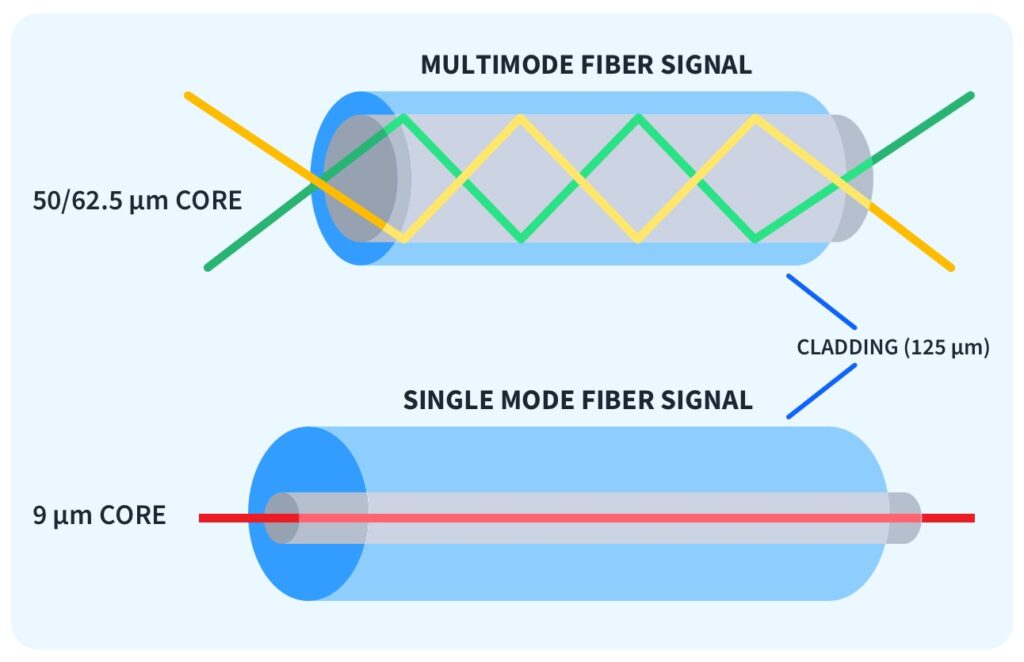Introduction
In today’s digitally driven world, high-speed data transmission is critical for businesses, telecommunications, and internet services. Fiber optic cables have revolutionized communication by enabling faster, more reliable data transfer compared to traditional copper cables. Among fiber optics, the two most common types are single-mode optical cable and multimode optical cable. While both serve the same fundamental purpose—transmitting data via light signals—they differ significantly in design, performance, and application.
This comprehensive guide explores the key differences between single-mode and multimode fiber optic cables, helping you determine which one best suits your networking needs. We will examine their core structures, light transmission methods, bandwidth capabilities, distance limitations, costs, and ideal use cases.
What is Multimode Optic Cable?
Multimode optic cable is designed with a larger core diameter (typically 50 or 62.5 microns), allowing multiple light rays (modes) to travel simultaneously. This design makes it highly effective for short-distance data transmission, such as within buildings or data centers.
Key Features of Multimode Fiber:
- Core Diameter: 50µm (OM3/OM4) or 62.5µm (OM1)
- Light Source: Uses LEDs (Light Emitting Diodes) or VCSELs (Vertical-Cavity Surface-Emitting Lasers)
- Maximum Distance: Up to 550 meters (for 10 Gbps OM4 fiber)
- Common Applications:
- Local Area Networks (LANs)
- Data centers and server farms
- CCTV and security systems
- Medical imaging and industrial networks
Because of its larger core, multimode optic cable is easier to install and requires less precise alignment than single-mode fiber. However, its drawback is modal dispersion, where light signals scatter over long distances, limiting its effectiveness beyond a few hundred meters.
Core Diameter and Light Transmission
The core diameter is one of the most critical differences between single-mode and multimode fibers, directly affecting how light travels through the cable.
Multimode Fiber:
- Larger Core (50µm or 62.5µm): Allows multiple light modes to propagate.
- Light Dispersion: Due to multiple light paths, signals can overlap and degrade over long distances (modal dispersion).
- Best For: Short-range applications where high bandwidth is needed within a confined space.
Single-Mode Fiber:
- Smaller Core (8-10µm): Only permits a single light mode, reducing signal distortion.
- Minimal Dispersion: Laser light travels straight with almost no signal loss, making it ideal for long-distance communication.
- Best For: Telecommunications, internet backbones, and undersea cables.
This structural difference means that while multimode is cost-effective for short distances, single-mode is superior for high-speed, long-haul data transmission.
Bandwidth and Data Transmission Speed
Bandwidth determines how much data a fiber optic cable can transmit at once. Both single-mode and multimode fibers support high speeds, but their capabilities differ based on distance.
Multimode Fiber Bandwidth:
- Supports speeds up to 100 Gbps (with OM5 fiber)
- Effective for short distances (up to 550m for 10 Gbps)
- Suffers from modal dispersion, reducing speed over longer runs
Single-Mode Fiber Bandwidth:
- Offers virtually unlimited bandwidth with minimal loss
- Maintains high speeds (up to 400 Gbps and beyond) over 100+ kilometers
- Uses laser-based transmission, ensuring precision and efficiency
For enterprise networks requiring high-speed data transfer within a building, multimode is sufficient. However, internet service providers (ISPs) and telecom companies rely on single-mode for cross-country and intercontinental connections.
What is a Single Mode Optic Cable?
Single mode optic cable has a much thinner core (8-10µm) and allows only one light path, eliminating modal dispersion. It uses laser diodes for precise, long-distance data transmission with minimal signal loss.
Key Features of Single-Mode Fiber:
- Core Diameter: 8-10µm
- Light Source: Laser diodes (1310nm or 1550nm wavelengths)
- Maximum Distance: Up to 100 km (with amplification)
- Common Applications:
- Long-haul telecommunications
- Fiber-to-the-Home (FTTH) networks
- High-speed internet backbones
- Military and aerospace communications
Due to its superior long-distance performance, single mode optic cable is the preferred choice for ISPs, cloud service providers, and large-scale network infrastructures.
Cost Comparison: Installation and Maintenance
Budget plays a significant role in choosing between single-mode and multimode fiber.
Multimode Fiber Costs:
- Lower initial cost (cheaper transceivers, connectors, and installation)
- Easier to terminate and splice due to larger core
- Higher long-term costs if network expands beyond short distances
Single-Mode Fiber Costs:
- Higher initial investment (expensive laser equipment)
- Requires precision alignment during installation
- Lower maintenance costs over time (more durable and scalable)
While multimode is more affordable for small-scale deployments, single-mode provides better future-proofing for growing networks.
Choosing the Right Fiber for Your Needs
Selecting the best fiber optic cable depends on several factors:
When to Use Multimode Fiber:
✔ Short-distance networks (data centers, campuses, office buildings)
✔ High bandwidth needs within 500 meters
✔ Budget-friendly installations
When to Use Single-Mode Fiber:
✔ Long-distance communication (telecom, ISPs, undersea cables)
✔ Ultra-high-speed data transfer (100G, 400G, and beyond)
✔ Future scalability and minimal signal loss
Hybrid Solutions:
Some networks use both fiber types—multimode for internal connections and single-mode for external links.
Endnote
Both single-mode and multimode optical cables are essential for modern communication, but they serve different purposes. Multimode optic cable is ideal for short-range, high-bandwidth applications like data centers and LANs, while single mode optic cable excels in long-distance, high-speed transmission for telecom and internet backbones.
By understanding their differences in core size, light transmission, bandwidth, distance limits, and cost, you can make an informed decision for your network infrastructure. Whether you prioritize cost-efficiency or long-term scalability, choosing the right fiber optic cable ensures optimal performance and reliability for years to come.







